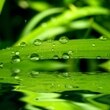
Bugleweed (Lycopus virginicus, Lycopus americanus, Lycopus europaes, Lycopus lucidus)
Background
Bugleweed was reportedly discovered on the banks of streams in the southeastern United States, but now grows throughout North America. Bugleweed has been used historically for an overactive thyroid, especially where symptoms include tightness of breath, palpitation (rapid and irregular heartbeat) and shaking.
Bugleweed has proposed astringent, blood sugar-lowering, mild narcotic, and mild sedative actions. Herbalists have traditionally used bugleweed to treat cough, mild heart conditions, bleeding in the lungs from tuberculosis, heavy menstruation, and to reduce fever and mucus production in the flu and colds. It has also has been used in combination with lemon balm for treating patients with Graves' disease and other forms of hyperthyroidism (overactive thyroid).
Currently there is a lack of high-quality clinical trials investigating the safety and efficacy of bugleweed.
Scientific Evidence
Uses | Grade* |
No available studies qualify for inclusion in the evidence table. | |
*Key to grades:
A: Strong scientific evidence for this use;
B: Good scientific evidence for this use;
C: Unclear scientific evidence for this use;
D: Fair scientific evidence against this use (it may not work);
F: Strong scientific evidence against this use (it likely does not work).
Tradition
- Astringent, breast pain (mastalgia), bruises, colds/flu (mucus production), cough, diuretic, gout, Graves disease (autoimmune disorder associated with overactive thyroid), heart conditions, hormone regulation, hypoglycemic agent (lowers blood sugar), hyperthyroidism, insomnia, menstrual problems, narcotic, nervousness, nosebleeds, premenstrual syndrome (PMS), sedative, snakebites, thyroid conditions, tuberculosis.
Dosing
Adults (18 years and older)
Historically, to treat snakebites, the root has been chewed, a portion swallowed, and the rest applied externally. Other doses that have been taken by mouth are: 0.2-2 grams of the aboveground plant parts daily; 10-30 drops of fluid extract daily; 1 ounce of dried herb in one pint of boiling water in "wineglassful doses;" 1-4 grains Lycopin (dry extract); and 1-2 grams of bugleweed in tea daily.
For bruising, bugleweed has been applied to the skin as a poultice of bugleweed leaves and other herbs.
Children (under 18 years old)
There is no proven safe or effective dose of bugleweed in children.
References
- Auf'mkolk M, Ingbar JC, Kubota K, et al. Extracts and auto-oxidized constituents of certain plants inhibit the receptor-binding and the biological activity of Graves' immunoglobulins. Endocrinology 1985;116(5):1687-1693. View Abstract
- Auf'mkolk M, Ingbar JC, Amir SM, et al. Inhibition by certain plant extracts of the binding and adenylate cyclase stimulatory effect of bovine thyrotropin in human thyroid membranes. Endocrinology 1984;115(2):527-534. View Abstract
- Auf'mkolk M, Kohrle J, Gumbinger H, et al. Antihormonal effects of plant extracts: iodothyronine deiodinase of rat liver is inhibited by extracts and secondary metabolites of plants. Horm.Metab Res 1984;16(4):188-192. View Abstract
- Bucar F and Kartnig T. Flavone Glucuronides of Lycopus virginicus. Planta Med 1995;61(4):378-380. View Abstract
- [Complementary medicine. Calming lycopus]. Schweiz Rundsch Med Prax 2004;93(51-52):2161. View Abstract
- Hiller E, Girod E. [Experimental studies on the effect of concentrates of Lycopus europaeus on thyroid gland with special reference to the histology of iodine metabolism.] Arzneimittelforschung 1954;4(6):380-388. View Abstract
- Hoerhammer L, Wagner H, Schilcher H. [On the knowledge of the constituents of Lycopus europaeus. 1. On the constituents of medicinal plants with hormone and antihormone-like action.] Arzneimittelforschung 1962;12:1-7. View Abstract
- Hussein AA, Rodriguez B. Isopimarane diterpenoids from Lycopus europaeus. J Nat Prod 2000;63(3):419-421. View Abstract
- Kartnig T, Buca F, Neuhold S. Flavonoids from the Aboveground Parts of Lycopus virginicus. Planta Med 1993;59(6):563-564. View Abstract
- Kong LD, Cai Y, Huang WW, et al. Inhibition of xanthine oxidase by some Chinese medicinal plants used to treat gout. J Ethnopharmacol 2000;73(1-2):199-207. View Abstract
- Rompel, A, Fischer, H, Meiwes, D, et al. Substrate specificity of catechol oxidase from Lycopus europaeus and characterization of the bioproducts of enzymic caffeic acid oxidation. FEBS Lett. 2-19-1999;445(1):103-110. View Abstract
- Sourgens, H, Winterhoff, H, Gumbinger, HG, et al. Antihormonal effects of plant extracts. Planta Med 1982;45(6):78-86. View Abstract
- Vonhoff, C, Baumgartner, A, Hegger, et al. Extract of Lycopus europaeus L. reduces cardiac signs of hyperthyroidism in rats. Life Sci 2-2-2006;78(10):1063-1070. View Abstract
- Wagner, H, Horhammer, L, and Frank, U. [Lithospermic acid, the antihormonally active principle of Lycopus europaeus L. and Symphytum officinale. 3. Ingredients of medicinal plants with hormonal and antihormonal-like effect]. Arzneimittelforschung. 1970;20(5):705-713. View Abstract